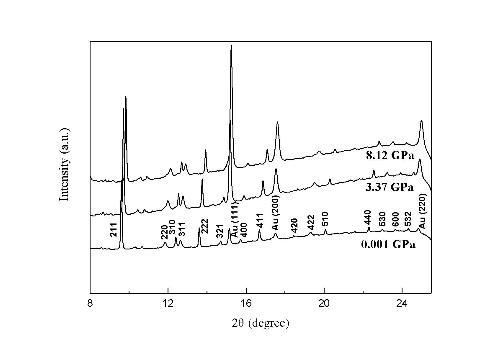 |
| Fig.Representative X-ray diffraction patterns of haüyne (Image by IGCAS) |
|
|
| TableCell parameters versus pressure for hauynite. |
 |
Haüyne is a tectosilicate mineral with sulfate. It is a sulphatic sodalite-group mineral. This mineral contains SO42- as the dominant interstitial anion, and it generally shows complex satellite reflections. Haüyne occurs in silica-deficient igneous rocks in a wide variety of locations. To date, the elastic properties of sodalite have been investigated in previous studies. But there are no reports in the literature about the physical properties including the equation of state (EoS), and elasticity of haüyne at high pressure. However, high pressure X-ray diffraction experiments not only provide us information such as phase transitions, it also gives us access to basic properties of elasticity, e.g. the bulk modulus. To gain a further understanding of the elastic property of haüyne, it would be useful to undertake the high pressure EoS investigation of this mineral. Prof. ZHOU Wenge’s group from Institute of Geochemistry, Chinese Academy of Sciences (IGCAS) has investigated the high-pressure behavior of a natural haüyne using in situ angle-dispersive x-ray diffraction and a diamond anvil cell up to 8.1 GPa.
In the research, they observed no phase change of haüyne up to 8.1 GPa. The reason is that as pressure increased, all the peaks shifted continuously toward higher 2θ and the diffraction lines broaden and weaken slightly, but the overall pattern did not change (See the Figure).
The effect of pressure on the unit-cell parameters and volume of haüyne are shown in the Table. The pressure-volume data have been fitted to the third-order Birch-Murnaghan equation of state to determine the elastic parameters:
P=(3/2) K0 [(V0/V)7/3-(V0/V)5/3]×{1+(3/4)(K′0-4)[ (V0/V)2/3-1]}, (1)
where V0, V, K0 and K′0 are the zero-pressure volume, and high-pressure volume, isothermal bulk modulus and its pressure derivative, respectively. The results from a least-squares fitting using an EosFit program are V0=751.6±0.4 Å3, K0=49±1 GPa, and K'0=3.3±0.3, respectively. When K'0 is set as 4, the isothermal bulk modulus is determined as 45.9(5) GPa.
In addition, by fitting a "linearized" third-order Birch-Murnaghan EoS, and following the procedure implemented in the EoSFit 5.2 program, they obtained the axial compressible modulus parameters (Ka0 = 48±1 GPa and K'0=3.4(3), respectively). Then, zero-pressure compressibilities from the haüyne P-V experimental data were found to be 6.94×10-3 GPa-1 for the a-axis. They also found that the haüyne was slightly more compressible than sodalite. Therefore, the zero-pressure compressibility of haüyne (6.94×10-3 GPa-1) is slightly higher than sodalite (6.4×10-3 GPa-1).
The above research is supported by the Mutual Foundation of Huge Scientific Equipment of National Natural Science Foundation of China and Chinese Academy of Sciences (Grant No. 10979053), the National Natural Science Foundation of China (Grant No. 41004035 and 90914008), and more results have been published in Physica B-Condensed Matter 2011, 406, 4404.
The link to the paper: http://www.sciencedirect.com/science/article/pii/S0921452611008635
(By FAN Dawei)